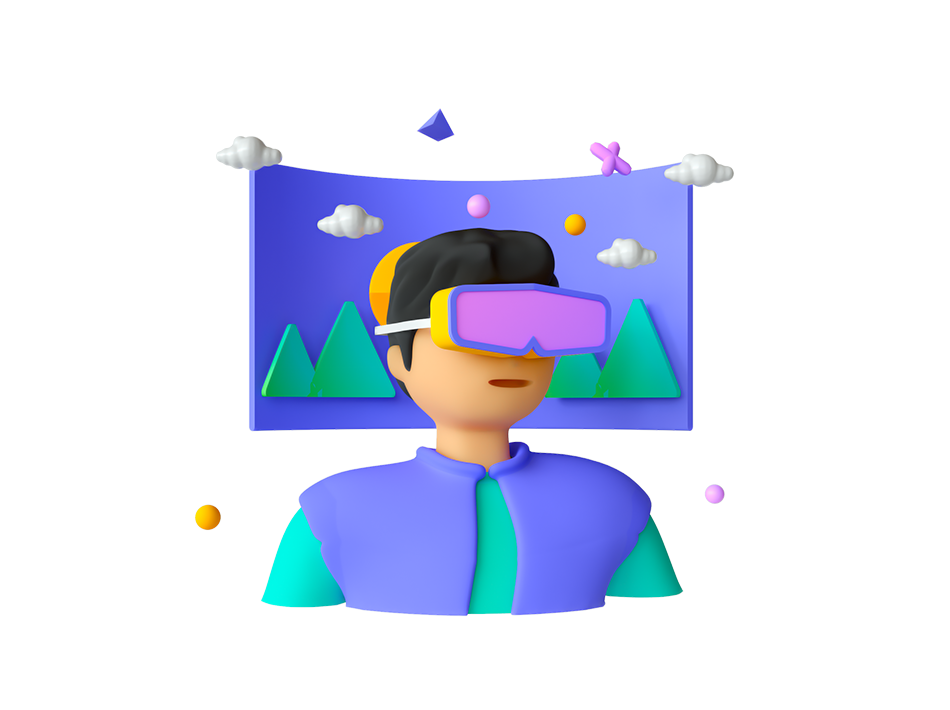An Immersive Feel Of A Virtual World.

Experience the Future of Technology with Virtual Reality Development
Virtual Reality (VR) is changing the way we interact with technology, offering an unparalleled level of immersion through computer-generated environments. With VR, users are transported to a new world that appears and feels real, perceived through VR headsets or helmets.
There are three primary categories of VR simulations available today: non-immersive, semi-immersive, and fully-immersive. Non-immersive simulations provide a basic experience, while semi-immersive simulations offer more interaction and movement. Fully-immersive simulations provide the ultimate VR experience, completely enveloping the user in a virtual world.
Virtual Reality development involves the creation of a simulated environment that can be explored in 360 degrees, providing an immersive experience that surpasses traditional interfaces. From gaming to training and beyond, VR offers endless possibilities for businesses and individuals alike.
Join the VR revolution and take your technology experience to the next level. With VR development, you can create engaging and immersive virtual environments that engage users in ways never before possible. Get started today and bring your vision to life with Virtual Reality.
How It Work
3 Effective Steps to Start a Streamlined Workflow
Research Project
Every business solution requires a robust and cutting-edge technical stack to avoid redundancy.
Targeting
We always strive to provide a fully automated software with the greatest features and effective reach.
Result
After approval from our quality assurance team, your system is ready for launch and delivers outstanding results.
Revolutionize Your Reality with VR Development by Earmark
Virtual Reality (VR) is the future of technology and Earmark is at the forefront of this revolution. Our VR development services are designed to help businesses and individuals engage with virtual environments and take their technology experience to the next level.
To get started in VR, Earmark offers practical training in product design, video game design, 3D modeling, animation, and design theory. Our expert instructors guide students through the process of developing fluency in VR development and what makes VR projects successful.
VR has the power to change the world around us and transform the way we learn and live. With VR development, students can explore new frontiers in education and experience learning in a completely new way.
In addition, VR has limitless applications in industries such as medicine, security, military, anti-terrorism, car crash awareness, weather forecasting, and more. By partnering with Earmark for your VR development needs, you are opening the door to a world of opportunities and revolutionizing your reality.
Get started today and join the VR revolution with Earmark
FAQ
VERTUAL REALITY (VR)
VR is often used for gaming, entertainment, and training purposes, but it also has applications in areas such as education, medicine, and psychology. In a VR environment, users can explore new worlds, experience simulations of real-life scenarios, and interact with virtual objects and characters.
Overall, Virtual Reality technology aims to enhance human sensory experiences and create new possibilities for how we interact with the world and with each other.
Gaming: VR is used to create immersive and interactive gaming experiences that allow players to fully engage with their virtual environment.
Entertainment: VR is used to create experiences that are beyond what is possible with traditional media, such as watching a movie or playing a video game.
Training: VR can be used to create realistic simulations for training purposes, such as for military or medical scenarios.
Education: VR is used to create educational experiences that are interactive and engaging, allowing students to learn through exploration and discovery.
Therapy: VR is used in therapy to treat a range of conditions, such as anxiety and phobias, by exposing patients to virtual environments that replicate real-life situations in a controlled and safe manner.
Design and visualization: VR can be used in the design and visualization of products, architecture, and other creative projects, allowing designers to test their ideas in a virtual environment.
Overall, VR is useful because it offers a new level of immersion and interactivity that is not possible with traditional technology. It has the potential to transform various industries and enhance the way we live, work, and play.
Hardware: VR typically involves the use of a headset or device that covers the eyes and provides a visual display, as well as a tracking system that follows the movements of the user. Some VR systems also include handheld controllers that allow the user to interact with the virtual environment.
Software: VR software is responsible for creating the virtual environment and simulating real-life interactions. This includes 3D modeling and animation, as well as programming and scripting to create the logic and behavior of virtual objects and characters.
Content creation: The virtual environment and the objects within it must be created and designed to provide an immersive experience for the user. This involves a combination of art and technical skills, such as 3D modeling, texturing, lighting, and animation.
Testing and optimization: Before release, VR experiences must be thoroughly tested and optimized to ensure that they run smoothly and provide a high-quality experience for the user.Overall, creating a Virtual Reality experience requires a collaboration of skills and expertise from various areas, including hardware engineering, software engineering, and design and art. The process can be complex and time-consuming, but the end result can be a truly immersive and interactive experience for the user.
Virtual World: This refers to the computer-generated environment or simulation that is created to provide an immersive experience for the user. The virtual world can include scenes, objects, and characters that are designed to appear realistic and interact with the user in real-time.
Immersion: Immersion refers to the level of presence that the user feels within the virtual environment. This can be achieved through various means, such as high-resolution displays, accurate tracking systems, and realistic audio and haptic feedback.
Tangible Input: Tangible input refers to the way that the user interacts with the virtual environment. This can include using hand-held controllers, body tracking systems, or other forms of physical interaction. The goal is to create a seamless and intuitive experience for the user.
Interactivity: Interactivity refers to the level of interaction that the user has with the virtual environment and the objects within it. This can range from simple interactions, such as moving objects or changing scenes, to more complex interactions, such as solving puzzles or playing games.
These components work together to create a seamless and immersive Virtual Reality experience for the user. By combining advanced hardware and software technologies, VR has the potential to provide new and exciting ways for people to engage with technology and each other.
Gaming:VR has become increasingly popular in the gaming industry as a way to provide a more immersive and interactive experience for players. VR games can range from simple arcade-style experiences to complex role-playing games.
Healthcare: VR is being used in the healthcare industry to provide patients with exposure therapy for phobias, post-traumatic stress disorder (PTSD), and other mental health conditions. VR can also be used to train medical professionals in a safe and controlled environment.
Education and Training: VR can be used to provide hands-on training and education in a safe and controlled environment. This can include training for military, law enforcement, and emergency response personnel, as well as vocational training and apprenticeships.
Design and Architecture: VR is being used in the fields of design and architecture to create virtual prototypes and walkthroughs of buildings, landscapes, and products. This allows designers and architects to see how their designs will look and function before they are built.
Tourism and Travel: VR is being used to provide virtual tours and experiences for travelers, allowing them to explore destinations and attractions from the comfort of their own home.
Film and Entertainment: VR is also being used in the film and entertainment industries to create immersive experiences for audiences. This can include VR movies, VR theme park attractions, and VR live events.
These are just a few examples of the many ways that VR is being utilized across various industries and fields. The technology is still relatively new, and there is significant potential for future growth and development in a variety of other areas as well.
Improving Mental Health: VR has been shown to be an effective tool for treating mental health conditions, such as anxiety and PTSD. This is because VR allows patients to be fully immersed in a controlled environment where they can confront their fears and phobias in a safe and controlled manner.
Enhancing Education and Training: VR has the potential to revolutionize the way we learn and train. With VR, students can be transported to virtual environments that mimic real-world scenarios, allowing them to gain hands-on experience in a safe and controlled environment. This can be particularly valuable for fields like medicine, where traditional training methods may be limited.
Driving Innovation: VR has the potential to drive innovation across a wide range of industries, from gaming and entertainment to healthcare and education. As VR technology continues to advance, it will likely open up new possibilities for creativity and innovation that we can't yet imagine.
Improving Accessibility: VR has the potential to improve accessibility in many areas, particularly for those with disabilities. For example, VR can be used to provide virtual access to cultural events, museums, and other attractions, allowing people with disabilities to experience these things in a way that would be impossible in the real world.
Driving Economic Growth: As VR becomes more widely adopted, it will likely drive economic growth in a number of ways. For example, it may lead to the creation of new jobs in fields like VR development and design, and it may also increase consumer spending in areas like gaming and entertainment.
These are just a few examples of the many ways that VR has the potential to influence the world. It is still a relatively new technology, and it will likely continue to evolve and change in ways that we cannot yet predict. However, the potential for VR to have a positive impact on society is clear, and it will be exciting to see how it develops and evolves in the years to come.







